
Wine Culture and Information since 2002 - Volume 22
 Wine Culture and Information since 2002 - Volume 22 |
|
Issue 181, February 2019 |
Contents |
|
|
The Charm of Roundness |
|
The taste of wine has undergone, and continues to undergo, undeniable changes, a condition evidently accompanying the beverage of Bacchus from the dawn of its discovery. These changes, which have inevitably influenced the consumption habits and preferences of the last twenty years, have been characterized by sudden changes of direction, as well as returns to the past. From the domination of red wines to the supremacy of the whites, then going back to the reds, looking with interest at the bubbles and without disdaining white wines again. It is not just a matter of enological styles, but also of specifics sensorial qualities, from dry to sweet and then back to dry, the taste and preferences influencing the world of wine have never ceased to move into an endless change. In all these changes in consumption and taste preferences, a quality seems to resist unaltered the effects of time: roundness. This particular sensorial sensation – not to be confused with sweetness – seems to be eternal, so much so that it is definitely fascinating for many wine lovers. An easy sensation to recognize, often a rabbit pulled out of a hat in many wines, a successful expedient for many wine makers, roundness never seems to see the sunset in the glasses of wine lovers. Roundness, undeniably, is capable of directly and immediately conquering the senses of any consumer, a quality often desired and wanted, it does not require much attention in order to be perceived and appreciated. In this regard – in case this could be of interest to someone – wines having a notable roundness do not meet my personal taste, but it is clear this particular sensorial and tactile quality is appreciated by many. In general terms, I prefer dry wines, sometimes also rough, with character and powerful personality, in any case having with elegance, however it is undeniable in certain wines roundness is capable of giving a better balance, harmony and class. What is roundness exactly? And why does it meet the taste and preferences of many consumers so easily? Defining roundness referred to wine is not easy because – in its definition – is caused by many substances, some of them capable of causing different stimuli, as in the case of alcohol and sugar or, more specifically, the so-called “polyalcohols” of which, as far as this stimulus is concerned, glycerol definitely is the most important one. Roundness is perceived in the mouth with a sensation, more or less intense, of a certain viscosity and “thickness”, such as to give wine, so to speak, a more “mellow” taste. As an example, we can consider, as a reference, the tactile sensation perceived in the mouth by water and butter respectively. Water flows easily and without impediments; butter, on the other hand, moves in the mouth more slowly and with an accentuated viscosity, also giving the sensation of “coating” the oral cavity. In wine, of course – except in case of specific defects and serious faults – the intense sensation of roundness produced by the butter will never be perceived, however there will be a perception recalling that stimulus, although decidedly lower. Roundness undeniably meets the favor of consumers because of its accommodating and reassuring mouth feel, easily understandable without concentrating too much, capable of vaguely remembering the simple satisfaction of sweet taste. A stimulus that often guarantees the commercial success of a wine, simply because it can easily meet the taste of a vast number of consumers. At the base of this success there are several factors, well-known to wine makers and producers who “create” this particular stimulus in their wines. This is generally achieved by using notoriously “round” grapes and by accentuating this quality with appropriate corrections through the addition of certain substances, absolutely legal, such as gum arabic. In this regard – and for the sake of clarity – gum arabic is also used as a wine stabilizer for its effect of limiting tartaric precipitation, but it is undeniable it also gives a more or less evident roundness. Moreover, gum arabic is also capable of lowering the astringency in wines as well as the perception of sensorial stimuli having a bitter taste, a characteristic which, obviously, further enhances roundness. There are also grapes that naturally produce wines with a perceptible roundness, among them, the most famous ones are Chardonnay and Merlot. These two grapes give an appreciable roundness to their wines, moreover, they are also well suited for the fermentation and aging in cask or barrique, a technique that further contributes to the sensation of roundness. The well-known characteristic of these two grapes, capable of making wines with a less sharp and more round quality, has been the foundation of their success, also blended to countless grapes, in particular those having a strong astringent and dry impact. In recent years there has been a lot of debates – and this subject is still alive – about the roundness in wines, often also in a derogatory and negative way, violently blaming Chardonnay, Merlot and barrique, responsible, according to these accusations, of excessive standardization and, of course, roundness. However round wines, regardless of what some say or prefer, continue to be successful and get the consensus of a large part of consumers. Blamed, for this reason, of having, so to speak, a simple taste and preference, even considered inexperienced or ignorant about wine, these consumers however continue to prefer this kind of wines and determine their commercial success. Producers, of course, are well-disposed and happy to satisfy them, both by using grapes that notoriously produce this sensation, and with enological techniques and practices capable of favoring it. Like i said, I do not belong to the category of those who appreciate the obvious roundness in wines, it is however undeniable their success is evident and indisputable. If we then consider roundness is a sensorial characteristic that has managed to survive in the course of the history of wine, even resisting to fierce criticism, not least important, sought by many, there surely is more than one good reason justifying its unaltered and accommodating charm. Antonello Biancalana
|
||||
Contrasts of Catarratto and Incrocio Bruni 54This month Catarratto – among the most important grapes of Sicily – is compared to the most famous of the crossings obtained by Prof. Bruno Bruni |
|
1900 has been a century in which have been introduced fundamental changes in Italian and European viticulture. A period marked by intense experimentation and research, often dictated by the need of finding a solution to new conditions and diseases for which neither the causes nor the remedies were known. We can consider, for example, the appearance of phylloxera in the European continent, a scourge that has seriously endangered the existence of vitis vinifera in Europe and, of course, in Italy. The need for experimentation, in Italy and elsewhere, was also dictated by the intent of improving the productivity and resistance of the vine to the greatest possible number of diseases with the aim of ensuring abundant harvests. In fact, it should be noted, at that time, the production of wine had a significant commercial importance as well as being considered as food and an element with a strong cultural and traditional connotation. The path followed for the experimentation was essentially one: the cross between different varieties with the aim of creating new ones. In fact, in the period from the end of the 1800s up to the first decades of the 1900s, it has been recorded the greatest number of new wine grapes, created by means of the crossing technique. An event which involved several researchers in almost all wine countries in Europe, in particular France and Italy. In Italy there have been many who worked for the improvement of the vine, and – among the many – are mentioned Luigi Manzoni, Giovanni Dalmasso, Bruno Bruni, Riccardo Terzi and Rebo Rigotti. One of the two grapes of this month's tasting by contrast – Incrocio Bruni 54 – is a representative of that period of research and will be compared with one of the most important grapes of Sicily – Catarratto – still today widely used for the production of wines in this island.
|
|
Catarratto is one of the most important and widespread white berried varieties of Sicily, cultivated in a large part of the island, is used for the production of many wines. The presence of this variety in Sicily has been documented for at least three centuries, but its origin is not entirely clear, although many believe Catarratto has very ancient origins. It is the most widespread white berried grape in Sicily and the impact of its cultivation is such that it is second only to the large Trebbiano family. Moreover, some genetic research has allowed the understanding Catarratto is the variety that – together with Moscato d'Alessandria, or Zibibbo – has created Grillo grape, result of a spontaneous crossing. Catarratto is also believed to be a progenitor of Garganega, a white grape of primary importance in Veneto region and also widespread in other Italian regions as well. Talking about Catarratto, it should be noted this important variety is classified in four distinct types. The fundamental research conducted in 1970 by Bruno Pastena identified four different types of Catarratto, classifying them as Comune or Latino, Lucido Spargolo, Lucido Serrato and Lucidissimo or Extralucido. The classification is essentially based on the shape of the bunch and it should be noted that, according to the Italian National Wine Variety Directory, it has been reduced to two types only: Catarratto Bianco Comune and Catarratto Bianco Lucido. Of these two types, Lucido is the most widespread, cultivated and used for the production of wines, and is considered the “real” Catarratto. This important Sicilian variety is used in the production of several white wines of the island and has, for years, conditioned the character of these wines, as they were easily prone to oxidation, and for this reason defined marsalati (that is, having a “Marsala” character). The use of modern enological practices have clearly improved this condition, and today wines produced with Catarratto are characterized by the finesse of their aromas and which can also have a certain character of complexity.
|
||||
|
The story of Incrocio Bruni 54 is, in some regards, unique and encircled – so to speak – by a certain aura of mystery concerning both its creation and its spreading. It is certain the creation of this variety was done by prof. Bruno Bruni, an ampelographer from Marches, who worked, among the other things, to the productive and qualitative improvement of vines for wine production. There are many varieties obtained by prof. Bruni, most of them are today extinct, and among them the most successful one is Incrocio Bruni 54. The year of its creation dates back to 1936, a period during which prof. Bruni seems to have been rather prolific in his activity of crossing grape varieties. This interesting variety, bearing the number 54, is the result of the crossing between the most important white berried wine grape of Marches – Verdicchio – and one of the most emblematic and so-called international grapes: Sauvignon Blanc. The intent of prof. Bruno Bruni was to create a valuable variety, especially in its aromatic quality, suitable for the hilly territories of Marches and Umbria regions, areas where, in fact, was recorded its maximum spreading. Prof. Bruni used to note the result of his crossings, in particular describing the enological potentials, a habit that – apparently – was not used for “54” and of which he gave a succinct description. After a good time of spreading, welcomed by wine producers of that time, the presence of Incrocio Bruni 54 has progressively reduced to the point of actually risking extinction. Thanks to the stubbornness and the renewed interest in this interesting variety, today Incrocio Bruni 54 is experiencing a new moment of glory, especially in the Marche region and, in particular, in the provinces of Ancona, Macerata and Pesaro-Urbino, where it is also known as Dorico. The interesting crossing between Verdicchio and Sauvignon Blanc produces wines in which can be perceived the sensory characteristics of both varieties, in particular, to the nose can be perceived the aromas of Sauvignon Blanc, whereas in the taste can be perceived the structure and elegance of Verdicchio.
|
The choice of wines for the tasting by contrast of this month will not be that difficult, especially for the wine produced with Catarratto. In fact, the Sicilian enological production offers a wide selection of wines produced with this white grape, therefore choosing a wine made from this variety is simple. The choice of the wine produced with Incrocio Bruni 54 instead presents a relative difficulty due to the small number of producers who are involved in the production of this variety. As for the Sicilian wine, our choice will be in favor of a Catarratto produced in the province of Trapani, specifically, the production of the Denomination of Controlled Origin (DOC) of Alcamo. The choice of Incrocio Bruni 54 will instead be in favor of a wine belonging to Marche Indicazione Geografica Tipica appellation, possibly produced in the northern territory of the region. It must be said Incrocio Bruni 54 is used in the production of some DOC wines of the region, however none of them provides for its use alone. Both wines belong to the most recent vintage and are produced in inert containers – therefore avoiding the use of wood – and served in tasting glasses at a temperature of 10 °C. (50 °F) Let's pour the wines into their respective glasses and start the tasting by contrast of this month from Alcamo Catarratto. As usual, we tilt the glass over a white surface – a sheet of paper is enough – and evaluate the color at the base of the glass. It is observed an intense and brilliant straw yellow color, with a high transparency: the object placed in contrast behind the glass is perfectly visible. The nuance of Catarratto – observed at the end of the glass, towards the opening – confirms a straw yellow color, sometimes tending to gold. Let's now pass to the evaluation of color in Marche Incrocio Bruni 54, by observing the base of the tilted glass. The color of this wine does not differ much from Catarratto, therefore confirming the intense and brilliant straw yellow hue. The nuance of the Incrocio Bruni 54, compared to the Sicilian wine, tends to show a greenish-yellow hue, however, depending on the enological technique used for production. The olfactory profiles of Catarratto and Incrocio Bruni 54 are characterized by substantial differences and, in many regards, even distant. The characteristic of the wines produced with Catarratto is that of offering aromas to the nose directly recalling flowers, including, of course, sensations associated to fruits. The most frequent flower aromas in Catarratto include hawthorn and broom, whereas as for fruit aromas, it can be perceived apple, pear, plum as well as almond. There are, in some cases, aromas reminiscent of tropical fruit, in particular pineapple. Moreover, in Catarratto can be recognized aromas of aromatic herbs such as rosemary and oregano. The profile of Incrocio Bruni 54 is very different, in which the typical aromas of the varieties that have generated this grape can be recognized: Verdicchio and Sauvignon Blanc. In this variety, in fact, we can perceive green apple, mango, peach, citrus fruits and almond, as well as floral aromas recalling elder, hawthorn and broom. There are also sensations of aromatic herbs, especially sage. Let's proceed with the evaluation of the olfactory profiles of the wines of our tasting by contrast, starting, as for the previous phases, from Alcamo Catarratto. Let's keep the glass in vertical position and, without swirling, we proceed with the first smell in order to evaluate the opening of the wine. Aromas of apple, plum and hawthorn emerge from the glass, intense and clean, as well as sensations reminiscent of citrus fruits. After having swirled the glass – operation that will favor the development of other olfactory qualities – the profile of Catarratto is completed with broom, pear and almond. To these are sometimes added hints of tropical fruit, in particular pineapple. Let's move on to the glass of Marche Incrocio Bruni 54 and evaluate its opening: from the glass we perceive intense and clean aromas of green apple, kiwi and, often, elder flower, blending – in this sense – the aromatic qualities of both Verdicchio and Sauvignon Blanc. After having swirled the glass, the olfactory profile of Incrocio Bruni 54 is completed with sensations of citrus fruits, hawthorn, mango, peach, almond, anise and sage. It is now the time to taste the wines of our tasting by contrast, therefore evaluating the respective gustatory profiles, starting – just like the previous phases – from Alcamo Catarratto. Let's take a sip of this wine and evaluate its attack, that is, the initial sensations produced in the mouth. It is perceived a distinct crispness, given by acidity, with a good structure and a moderate alcoholic strength, however enough to balance crispness. In the mouth can be perceived flavors of apple, plum and pear, confirming the good correspondence to the nose. Let's now pass to the taste of Marche Incrocio Bruni 54 and take the first sip. Also in tihs case is perceived a clear perception of crispness given by acidity – a common quality of both Verdicchio and Sauvignon Blanc – as well as a good structure and the pseudo-caloric perception of alcohol, enough to make the wine balanced. Moreover, in the mouth are also perceived flavors of green apple, kiwi and peach, as well as hints of exotic fruit, in particular mango. The last phase of the tasting by contrast will focus on the evaluation of the final sensations both wines leave in the mouth, in particular the taste-olfactory persistence, one of the primary factors determining quality. The finish of Alcamo Catarratto is of good persistence, leaving in the mouth, flavors of apple, plum and pear, as well as a hint of almond. It can also be perceived the sensation of crispness and structure, with an overall agreeableness. The finish of Marche Incrocio Bruni 54 is characterized by good persistence, with flavors of green apple, kiwi and peach, often followed by a pleasant hint of almond, typical of Verdicchio. The acidity is clearly perceptible in the mouth and, the general impression we get from the comparison, it has a greater structure than Catarratto. Let's now take another sip of both wines, first Alcamo Catarratto and then Marche Incrocio Bruni 54: the gustatory differences of the two wines are clear and evident, especially in the sensations respectively left in the mouth after swallowing.
|
||||||||
Wines of the Month |
|
|
|
Score legend Prices are to be considered as indicative. Prices may vary according to the country or the shop where wines are bought |
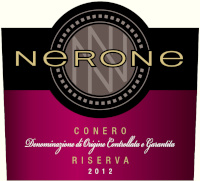
|
|
Conero Riserva Nerone 2012 |
|
| Terre Cortesi Moncaro (Marches, Italy) | |
 Montepulciano Montepulciano | |
| Price: € 30.00 | Score: |
 Deep ruby red and nuances of garnet red, little transparency. Deep ruby red and nuances of garnet red, little transparency. Intense, clean, pleasing, refined and elegant, starts with hints of
plum, black cherry and dried violet followed by aromas of blackberry,
blueberry, tobacco, carob, chocolate, coffee, cinnamon, licorice, vanilla
and menthol. Intense, clean, pleasing, refined and elegant, starts with hints of
plum, black cherry and dried violet followed by aromas of blackberry,
blueberry, tobacco, carob, chocolate, coffee, cinnamon, licorice, vanilla
and menthol.
 Properly tannic attack and however balanced by alcohol, full body,
intense flavors, pleasing roundness. Properly tannic attack and however balanced by alcohol, full body,
intense flavors, pleasing roundness.
 Persistent finish with flavors of plum, black cherry and blackberry. Persistent finish with flavors of plum, black cherry and blackberry. 15 months in barrique, 12 months in bottle. 15 months in barrique, 12 months in bottle. |
|
 Game, Roasted meat, Braised and stewed meat, Hard cheese Game, Roasted meat, Braised and stewed meat, Hard cheese |
|

|
|
Verdicchio dei Castelli di Jesi Passito Tordiruta 2011 |
|
| Terre Cortesi Moncaro (Marches, Italy) | |
 Verdicchio Verdicchio | |
| Price: € 30.00 - 500ml | Score: |
 Brilliant amber yellow and nuances of amber yellow, moderate
transparency. Brilliant amber yellow and nuances of amber yellow, moderate
transparency.
 Intense, clean, pleasing, refined and elegant, starts with hints of
dried apricot, raisin and candied fruits followed by aromas of dried fig,
quince jam, peach jam, lychee, almond, date, honey, citrus fruit peel, nail
polish and hints of vanilla. Intense, clean, pleasing, refined and elegant, starts with hints of
dried apricot, raisin and candied fruits followed by aromas of dried fig,
quince jam, peach jam, lychee, almond, date, honey, citrus fruit peel, nail
polish and hints of vanilla.
 Sweet and round attack, however balanced by alcohol, good body, intense
flavors, pleasing crispness. Sweet and round attack, however balanced by alcohol, good body, intense
flavors, pleasing crispness.
 Persistent finish with flavors of dried apricot, raisin and candied
fruits. Persistent finish with flavors of dried apricot, raisin and candied
fruits.
 Fermented and aged in barrique for 12 months, 1 year in bottle. Fermented and aged in barrique for 12 months, 1 year in bottle. |
|
 Jam and dried fruit tarts, Hard and piquant cheese Jam and dried fruit tarts, Hard and piquant cheese |
|
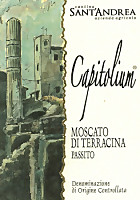
|
|
Moscato di Terracina Passito Capitolium 2015 |
|
| Sant'Andrea (Latium, Italy) | |
 Moscato di Terracina Moscato di Terracina | |
| Price: € 12.50 - 500ml | Score: |
 Brilliant amber yellow and nuances of amber yellow, moderate
transparency. Brilliant amber yellow and nuances of amber yellow, moderate
transparency.
 Intense, clean, pleasing and refined, starts with hints of raisin,
dried fig and caramel followed by aromas of dried apricot, candied fruits,
quince jam, peach jam, date, citrus fruit peel, honey and nail polish. Intense, clean, pleasing and refined, starts with hints of raisin,
dried fig and caramel followed by aromas of dried apricot, candied fruits,
quince jam, peach jam, date, citrus fruit peel, honey and nail polish.
 Sweet and round attack, however balanced by alcohol, good body, intense
flavors, pleasing crispness. Sweet and round attack, however balanced by alcohol, good body, intense
flavors, pleasing crispness.
 Persistent finish with flavors of raisin, dried fig, quince jam. Persistent finish with flavors of raisin, dried fig, quince jam. 6 months in cask. 6 months in cask. |
|
 Dried fruit desserts, Hard cheese Dried fruit desserts, Hard cheese |
|
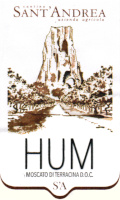
|
|
Moscato di Terracina Hum 2014 |
|
| Sant'Andrea (Latium, Italy) | |
 Moscato di Terracina Moscato di Terracina | |
| Price: € 21.00 | Score: |
 Deep golden yellow and nuances of golden yellow, transparent. Deep golden yellow and nuances of golden yellow, transparent. Intense, clean, pleasing, refined and elegant, starts with hints of
grape, honey and iodine followed by aromas of apple, dried apricot, ripe
peach, bergamot, pear, lychee, citrus fruit peel, pineapple, sage, dried
rose and mineral. Intense, clean, pleasing, refined and elegant, starts with hints of
grape, honey and iodine followed by aromas of apple, dried apricot, ripe
peach, bergamot, pear, lychee, citrus fruit peel, pineapple, sage, dried
rose and mineral.
 Crisp attack and however balanced by alcohol, good body, intense
flavors, agreeable. Crisp attack and however balanced by alcohol, good body, intense
flavors, agreeable.
 Persistent finish with flavors of grape, honey and dried apricot. Persistent finish with flavors of grape, honey and dried apricot. Aged in steel tanks. Aged in steel tanks. |
|
 Broiled crustaceans, Pasta with fish, Mushroom soups, Roasted fish Broiled crustaceans, Pasta with fish, Mushroom soups, Roasted fish |
|
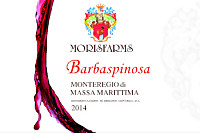
|
|
Monteregio di Massa Marittima Rosso Barbaspinosa 2014 |
|
| Moris Farms (Tuscany, Italy) | |
 Sangiovese (90%), Cabernet Sauvignon (10%) Sangiovese (90%), Cabernet Sauvignon (10%) | |
| Price: € 12.90 | Score: |
 Brilliant ruby red and nuances of ruby red, little transparency. Brilliant ruby red and nuances of ruby red, little transparency. Intense, clean, pleasing and refined, starts with hints of black
cherry, plum and violet followed by aromas of black currant, blueberry,
blackberry, chocolate, tobacco, mace, vanilla and eucalyptus. Intense, clean, pleasing and refined, starts with hints of black
cherry, plum and violet followed by aromas of black currant, blueberry,
blackberry, chocolate, tobacco, mace, vanilla and eucalyptus.
 Properly tannic attack and however balanced by alcohol, good body,
intense flavors, agreeable. Properly tannic attack and however balanced by alcohol, good body,
intense flavors, agreeable.
 Persistent finish with flavors of black cherry, plum and black currant. Persistent finish with flavors of black cherry, plum and black currant. 18 months in barrique, 4 months in bottle. 18 months in barrique, 4 months in bottle. |
|
 Broiled meat and barbecue, Roasted meat, Stewed and braised meat with mushrooms, Hard cheese Broiled meat and barbecue, Roasted meat, Stewed and braised meat with mushrooms, Hard cheese |
|
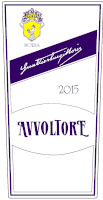
|
|
Avvoltore 2015 |
|
| Moris Farms (Tuscany, Italy) | |
 Sangiovese (75%), Cabernet Sauvignon (20%), Syrah (5%) Sangiovese (75%), Cabernet Sauvignon (20%), Syrah (5%) | |
| Price: € 32.00 | Score: |
 Intense ruby red and nuances of ruby red, little transparency. Intense ruby red and nuances of ruby red, little transparency. Intense, clean, pleasing, refined and elegant, starts with hints of
black cherry, plum and black currant followed by aromas of violet,
blueberry, raspberry, peony, face powder, chocolate, tobacco, pink pepper,
menthol and vanilla. Intense, clean, pleasing, refined and elegant, starts with hints of
black cherry, plum and black currant followed by aromas of violet,
blueberry, raspberry, peony, face powder, chocolate, tobacco, pink pepper,
menthol and vanilla.
 Properly tannic attack and however balanced by alcohol, full body,
intense flavors, pleasing roundness. Properly tannic attack and however balanced by alcohol, full body,
intense flavors, pleasing roundness.
 Persistent finish with flavors of black cherry, plum and black currant. Persistent finish with flavors of black cherry, plum and black currant. 12 months in barrique, 6 months in bottle. 12 months in barrique, 6 months in bottle. |
|
 Game, Roasted meat, Braised and stewed meat, Hard cheese Game, Roasted meat, Braised and stewed meat, Hard cheese |
|
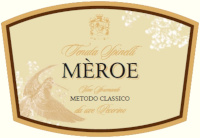
|
|
Spumante Metodo Classico Brut Meroe |
|
| Tenuta Spinelli (Marches, Italy) | |
 Pecorino Pecorino | |
| Price: € 17.00 | Score: |
 Brilliant straw yellow and nuances of straw yellow, very transparent,
fine and persistent perlage. Brilliant straw yellow and nuances of straw yellow, very transparent,
fine and persistent perlage.
 Intense, clean and pleasing, starts with hints of apple, plum and bread
crust followed by aromas of citrus fruits, hawthorn, broom and yeast. Intense, clean and pleasing, starts with hints of apple, plum and bread
crust followed by aromas of citrus fruits, hawthorn, broom and yeast.
 Effervescent and crisp attack, however balanced by alcohol, good body,
intense flavors, agreeable. Effervescent and crisp attack, however balanced by alcohol, good body,
intense flavors, agreeable.
 Persistent finish with flavors of apple, plum and bread crust. Persistent finish with flavors of apple, plum and bread crust. Refermented in bottle on its lees for 24 months. Refermented in bottle on its lees for 24 months. |
|
 Pasta with fish, Broiled fish and crustaceans, Roasted white meat Pasta with fish, Broiled fish and crustaceans, Roasted white meat |
|

|
|
Offida Pecorino Artemisia 2017 |
|
| Tenuta Spinelli (Marches, Italy) | |
 Pecorino Pecorino | |
| Price: € 10.00 | Score: |
 Brilliant straw yellow and nuances of greenish yellow, very
transparent. Brilliant straw yellow and nuances of greenish yellow, very
transparent.
 Intense, clean, pleasing and refined, starts with hints of apple,
medlar and hawthorn followed by aromas of pear, grapefruit, plum, peach,
broom, citron, pineapple and anise. Intense, clean, pleasing and refined, starts with hints of apple,
medlar and hawthorn followed by aromas of pear, grapefruit, plum, peach,
broom, citron, pineapple and anise.
 Crisp attack and however balanced by alcohol, good body, intense
flavors, agreeable. Crisp attack and however balanced by alcohol, good body, intense
flavors, agreeable.
 Persistent finish with flavors of apple, medlar and grapefruit. Persistent finish with flavors of apple, medlar and grapefruit. Aged in steel tanks. Aged in steel tanks. |
|
 Pasta with fish, Fried fish, Stewed fish Pasta with fish, Fried fish, Stewed fish |
|
News |
|
In this section are published news and information about events concerning the world of wine and food. Whoever is interested in publishing this kind of information can send us a mail to our address.
|
AquavitaeReview of Grappa, Distillates and Brandy |
|
|
||||||||||||
Wine Guide ParadeNovember 2018
|
| |||||||
Privacy Policy | |||||||


| Copyright © 2002-2024 Antonello Biancalana, DiWineTaste - All rights reserved |
| All rights reserved under international copyright conventions. No part of this publication and of this WEB site may be
reproduced or utilized in any form or by any means, electronic or mechanical, without permission in writing from DiWineTaste. |